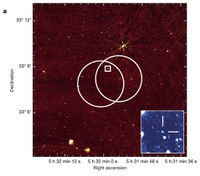A Fast Radio Burst and its Host
Fast Radio Bursts (FRBs) are astronomical radio flashes of an unknown physical nature with durations of milliseconds. Their dispersive arrival times suggest an extragalactic origin and imply radio luminosities orders of magnitude larger than those of all known short-duration radio transients. To date, all FRBs have been detected with large single-dish telescopes with arcminute localizations, and attempts to identify their source or host galaxy have relied on the contemporaneous variability of field sources or the presence of peculiar field stars or galaxies. These attempts have not resulted in an unambiguous association with a host or multi-wavelength counterpart.
In this contribution, Chatterjee et al. report the sub-arcsecond localization of FRB 121102, the only known repeating burst source, using high-time-resolution VLA radio that directly image the bursts. This precise localization revealed that FRB 121102 originates within 100 milli-arcseconds of a faint 180 micro-Jansky persistent radio source with a continuum spectrum consistent with non-thermal emission, and a faint optical counterpart. The flux density of the persistent radio source varies by ~10% on day timescales, and very long baseline radio interferometry yields an angular size of < 1.7 milli-arcseconds. These observations are inconsistent with the FRB having a Galactic origin or its source being located within a prominent star-forming galaxy. Instead, the source appears to be co-located with a low-luminosity active galactic nucleus or a previously unknown type of extragalactic source. Localization and identification of a host or counterpart has been essential to understanding the origins and physics of other kinds of transient events, including gamma-ray bursts and tidal disruption events. However, if other FRBs have similarly faint radio and optical counterparts, this research implies that direct sub-arcsecond localizations may be the only path to reliable associations.
Image: VLA image (3 GHz) of the FRB field at 2 arcsec resolution. The overlapping white circles are the Arecibo Observatory detection uncertainty regions (3′ beam FWHM). The radio counterpart of the bursts detected by the VLA is highlighted in a 20 arcsec white square within the overlap. [Inset] Gemini Observatory image of the 20 arcsec square showing an optical counterpart (rAB = 25.1 ± 0.1 mag), as identified by the 5 arcsec bars.
Publication: Shami Chatterjee (Cornell University) et al., A Direct Localization of a Fast Radio Burst and its Host, 2017, Nature, 541, 58.





Connect with NRAO